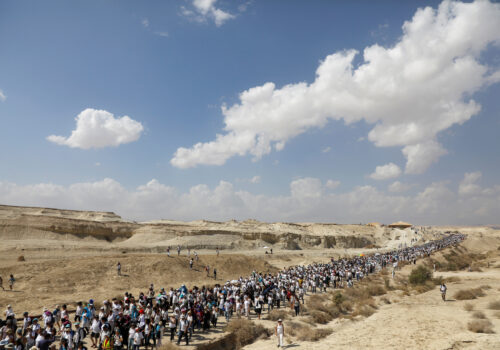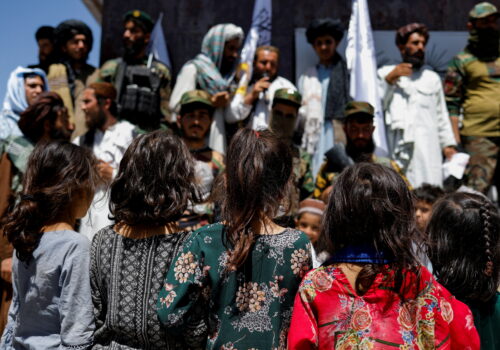By some accounts, the global economy is finally looking up in 2024, lifted by the perhaps unexpected strength of the US economy and buoyed by cooling inflation, supply chain smoothing, and increasing employment worldwide. At the same time, a potent mix of geopolitical challenges—including debt, conflict, and increasing climate events—threaten to cloud this otherwise sunny outlook. And there are still divergences among countries in terms of economic resilience and recovery, as well as persistent, if not widening, inequalities within them.
The divergences caused by fragility, conflict, and violence (FCV) situations are particularly stark, as the incidence of conflict events has increased 40 percent since 2020, to the highest number of events since World War II. Half of the world’s poor live in FCV-affected countries and that number is expected to rise to 60 percent by 2030, in part as the duration of conflicts extends—to now an average of twenty years. In addition to the death, destruction, and disruptions they cause, conflict and fragility are disincentives to investment and further undermine economic growth. One-fifth of International Monetary Fund member countries are considered fragile and conflict-affected situations (FCS) and twenty of the most climate-vulnerable economies are also on the World Bank’s FCS list.
According to the most recent Women, Peace, and Security Index: “In 2022, approximately six hundred million women—15 percent of women in the world—lived within fifty kilometers of armed conflict, more than double the levels in the 1990s.” These numbers don’t lie, but they also don’t necessarily tell the whole truth. And the truth is that women and girls are disproportionately impacted by fragility and conflict economically, socially, and politically. The impacts are well-documented. The data show, for example, that women and girls are more likely to see their educations disrupted, are more vulnerable to gender-based violence, and are more likely to be displaced or become refugees.
Women often face much greater economic hardships than men in conflict-affected areas, as well. Notably, six out of ten of the World Bank’s FCS countries are in the lower quartile on the “Economic Participation and Opportunity” subindex on the World Economic Forum’s Global Gender Gap Index, indicating wider gender gaps and more challenges facing women in conflict contexts. Similarly, a majority of FCV countries can be found in the bottom of the latest Women Business and the Law rankings released on March 4. These impacts also further undermine economies: The World Bank estimates that gender-based violence costs some countries up to 3.7 percent of gross domestic product (GDP), and a 1 percent increase in violence against women lowers economic activity by 9 percent.
The roles women hold during conflict and reconstruction
But there can be opportunities for women’s economic empowerment in conflict and reconstruction, as well. Women are experiencing these outcomes despite the important role they play in economies during conflict, in post-conflict reconstruction, and in efforts to sustain peace.
Most of today’s FCV economies are characterized by low female labor force participation. For example, in 2022, the United Nations estimated that closing gender gaps in women’s labor force participation in Yemen would increase the country’s GDP by 27 percent. War has historically created windows of opportunity for women to fulfill workforce shortages—including in male-dominated fields—since men make up a majority of combatants. War—often coupled with crippling inflation—makes finding paid work more acceptable and, importantly, this openness tends to continue as income generation changes women’s economic value and power in society. In the United States, for example, women took to manufacturing and government administration for the war industry and beyond during World War II, with nineteen million women entering the US workforce during this period. Today, women continue to join or rejoin the workforce—including in the informal sector—at higher rates amid conflict and take on more culturally nontraditional jobs. For instance, Ukrainian women have joined the mining workforce, filling the gaps left by conscription after Russia’s invasion.
Like most economies worldwide, micro, small, and medium-sized enterprises dominate the market landscape of fragile and conflict-torn countries.
Even though these smaller businesses face more start-up and operational constraints, they provide a key pathway for women’s economic participation during conflict and on the road to recovery. A study in Syria estimated that the proportion of female entrepreneurs increased from a low base of 4.4 percent in 2009 to 22.4 percent by 2017. This includes women-owned and -led businesses engaging in supply chains; including in the logistics, information, and communication technology, infrastructure, and public works sectors, all of which are critical to reconstruction.
And as women workers and their businesses earn more, especially in the formal economy, they can mitigate the otherwise dampening domestic resource mobilization associated with reduced economic activity, investment, and government administration during conflict or destabilization. Women’s greater participation in the economy during conflict and reconstruction can also increase consumption and income utilization (including from cash transfers or other social protection mechanisms) as women recirculate their earnings with spending on their families.
How to wield prosperity and peace dividends with and for women
Gender inclusion cannot be an afterthought. Policymakers must address the immediate economic security and income needs of women during conflict, while empowering them to contribute to and benefit from recovery, reconstruction, and growth. This means providing context-specific, targeted social protections and addressing the issues that undermine women’s economic participation. It requires mitigating and responding to gender-based violence, as well as improving accessibility and affordability of child and elder care. It also means supporting women entrepreneurs and women-led small businesses, closing education or skill gaps, and addressing social and cultural norms that limit career choices or workforce participation with conflict or fragility-sensitive knowledge, design, and delivery mechanisms.
Depending on the type, level, and stage of FCV, as well as the economic landscape, certain FCV-specific interventions can also make a difference in women’s economic empowerment. These include, for example, enabling women’s earning, employment, and entrepreneurship by expanding opportunities in gig and home-based economies and increasing safe and reliable transportation to and from work or school. Policymakers should also take steps to improve access to education and training with attention to language, as well as the demand for and portability of skills and certifications. In addition to addressing persistent systemic and policy hurdles, women business owners and entrepreneurs need targeted support with more risk financing, knowhow, and market entry and development.
This includes leveraging sizable development and humanitarian assistance and procurement. The United Nations Office for Project Services (UNOPS), for example, bought over $1.8 billion worth of goods and services in 2022 from suppliers worldwide, with 56 percent local spending. Aligned with system-wide UN gender-responsive procurement initiatives, UNOPS is piloting and beginning to scale programs to train and prepare women business owners to successfully bid and execute their tenders. These women can then use the investment, experience, and credibility gained from working with UNOPS to obtain other public and private sector contracts and optimize supply chain opportunities.
Increasing digital inclusion can be transformative for women’s financial inclusion and economic participation, as well; including by training women for information and communication technology jobs in the digital economy, like the World Bank-Rockefeller Foundation’s Click-On Kaduna project in Nigeria. Policymakers should prioritize increasing women’s access to and utilization of digital tools and platforms, including digital money and financial services, as well as remote learning and government technology. Digital mechanisms can also serve as useful aspects of larger initiatives that empower women’s participation and leadership, which is critical for conflict mitigation and durable peacebuilding.
The evidence that expanding economic opportunities for women is intertwined with building inclusive and sustainable growth, as well as peace and social progress, is only accruing with time, experience, and data. On this International Women’s Day, aptly themed “Invest in Women: Accelerate Progress,” it is incumbent upon all leaders, investors, and policymakers to heed this call. Public and private sector actors would do well to invest and enable increased women’s economic participation to catalyze prosperity and peace.
Nicole Goldin is a nonresident senior fellow at the GeoEconomics Center.
Further reading
Thu, Mar 7, 2024
While wars rage on, women wage peace in the Middle East
MENASource By Marcy Grossman
On International Women’s Day this year, the world needs more voices echoing the resounding calls for peace and justice in the face of ongoing conflicts.
Fri, Mar 8, 2024
This International Women’s Day, hold the Taliban to account for gender apartheid
New Atlanticist By Azadah Raz Mohammad, Metra Mehran
Gender apartheid must be included as a standalone crime against humanity in international law. The United Nations has an opportunity to make that happen.
Thu, Mar 7, 2024
Not without her: A roadmap for gender equality and Caribbean prosperity
Report By Wazim Mowla, Valentina Sader
Caribbean development is intrinsically linked with women's equality. After a multi-month consultation process with Caribbean stakeholders, we offer a roadmap on how to achieve inclusive development in the region.
Image: Demonstrators take part in an International Women's Day rally, as women strike to demand the end to domestic and racist violence, wars and the country's prevailing "macho" culture, in Rome, Italy, March 8, 2024. REUTERS/Yara Nardi



